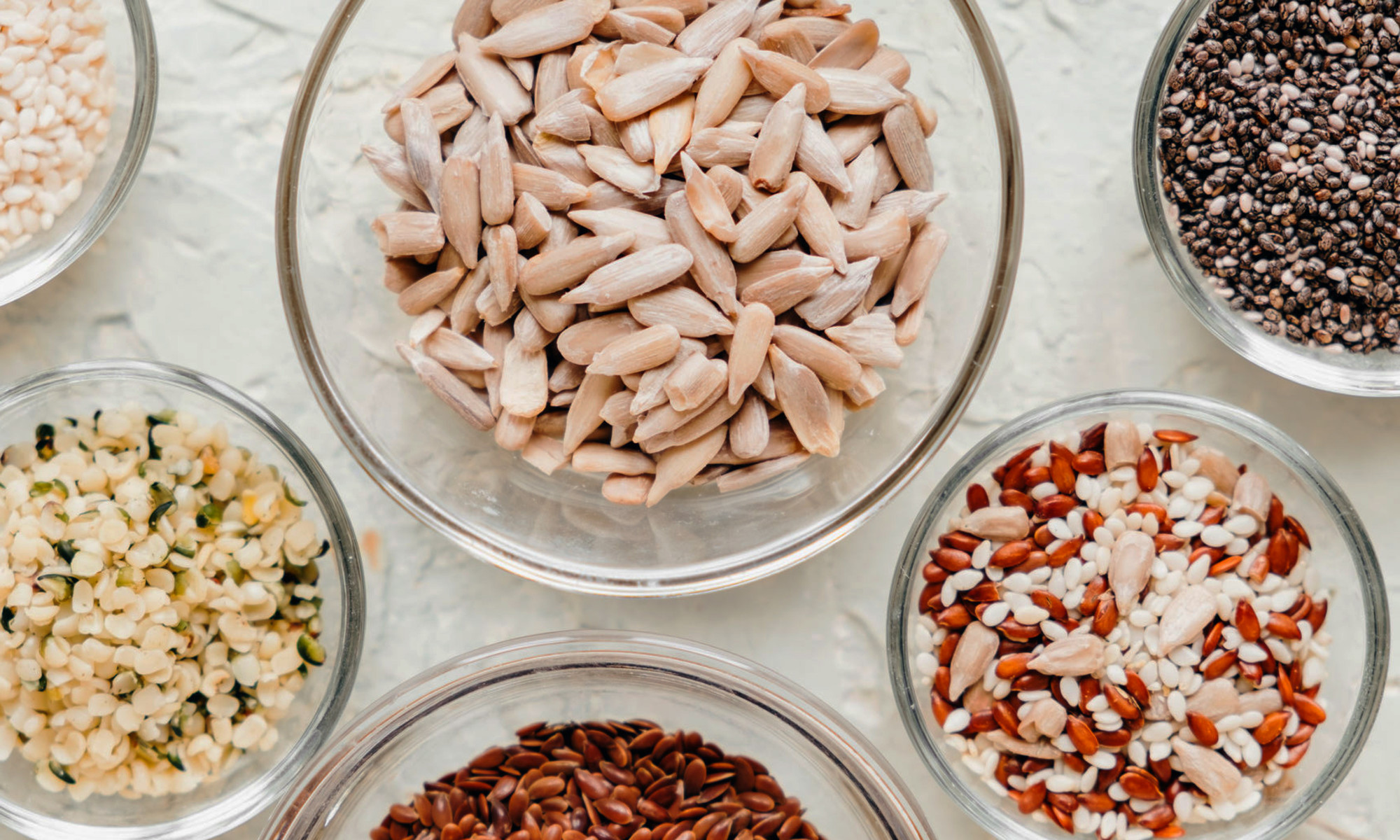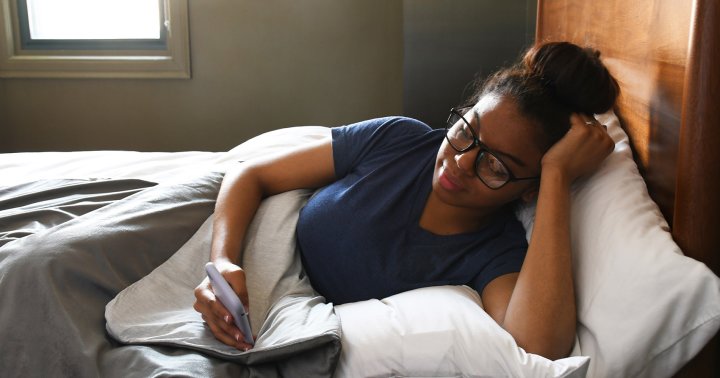Nutritionists Love To Use This Stealthy Seed To Sneak More Fiber Into Meals
Kick off your flax obsession with this simple smoothie recipe.

Image by Nataša Mandić / Stocksy May 31, 2023 Our editors have independently chosen the products listed on this page. If you purchase something mentioned in this article, we may If you’ve ever seen a field of flax, you’d probably never guess that at the base of these pretty, purple-flowered plants lie some of the world’s most nutritious seeds. Flaxseeds are well known for their sky-high level of alpha-linoleic (ALA) omega-3 fatty acids, ample antioxidants, and sizable protein and fiber content. Plus, their mild taste and thick texture when ground makes for a pleasant heft in smoothies, oatmeal, baked goods, and more. Here's a deep dive into some of the top benefits of flaxseeds and how to plant more of them into your diet.
Advertisement
This ad is displayed using third party content and we do not control its accessibility features.
What are flaxseeds?
Flax has been cultivated for thousands of years and, historically, has had multiple uses.
Its flowers can add color to bouquets, its fibers have long been used to make linen clothing, and its seeds can be ground into a nutritious powder. (Though it’s technically possible to eat flaxseeds in their whole form, it’s not the best idea. They’re considered nearly impossible to digest.)
Ounce for ounce, flaxseeds are fairly expensive, especially when you compare them to other seeds—but since a serving is just one tablespoon, a bag is likely to last you a while.
And while you probably wouldn’t want to eat ground flaxseed all by itself, it’s great for adding nutrients and bulk to a variety of common foods. A tablespoon of flaxseed soaked in water also makes a super-simple vegan egg substitute! As for taste, ground flaxseed won’t mess with the flavor of your pancakes or breads. It’s nutty with just a hint of earthiness and sweetness.
Summary
Flaxseeds come from flax plants, and they're typically ground into a powder to make them more digestible. While flaxseed powder is expensive, it's packed with nutrients and easy to incorporate into cooking and baking.
Advertisement
This ad is displayed using third party content and we do not control its accessibility features.
Flaxseed nutrition
Advertisement
This ad is displayed using third party content and we do not control its accessibility features.
Flaxseed benefits
Flaxseed and its oil are popular as both whole foods and supplements for their various health benefits. Here’s a look at several that have evidence to back them up.
1.
Flaxseed is beneficial for heart health
Advertisement
This ad is displayed using third party content and we do not control its accessibility features.
2.
They may support women’s health
Flaxseed may also offer benefits for women’s health. “Some research shows that the phytoestrogens in flaxseeds, called lignans, are great for women's health because they may lower the risk of breast cancer8 in women and may even reduce tumor growth in breast cancer patients,” says Gross. “This is because the lignans act as estrogen in the body.”
However, the data here isn’t perfectly clear-cut. “The research on this is limited, and for some women with certain types of breast cancer, intake of phytoestrogens could have the opposite effect,” Gross says. To be safe, people breast cancer will want to talk to their doctor if they're thinking about adding flaxseed to their diet.
3.
They may have skin and hair benefits
The internet is teeming with information on flaxseeds’ benefits for skin and hair—but does reality match the hype? Sort of. Though there are no human clinical trials on flaxseeds’ impact on hair or skin, animal studies are promising.
“There are two small but good-quality animal studies that show benefits,” says Maggie Moon, MS, RD, nutrition consultant and best-selling author of The MIND Diet. “A pilot study in horses found that six weeks of ground flaxseed supplementation helped heal cuts better and reduced inflammation9, all without negative side effects. And a month-long study in dogs found that daily supplementation with flaxseed or sunflower seed temporarily improved skin and hair10 after about two weeks. When supplementation stopped, so did the benefits.”
Granted, this doesn’t necessarily mean the same will hold true for humans, but Moon says that shouldn’t stop you from digging in. “People aren’t horses or dogs, but given the known benefits of enjoying flaxseed, there are plenty of other good reasons to partake.”
Advertisement
This ad is displayed using third party content and we do not control its accessibility features.
4.
They’re great for digestive health
Flaxseed meal is loaded with gut-boosting fiber at almost 2 grams per tablespoon. Desiree Nielsen, RD, the author of Eat More Plants, points out that the powder contains both soluble and insoluble fiber, each of which has benefits for digestive health.
Insoluble fiber is known for adding bulk to stool, allowing it to move through your digestive tract more quickly. Soluble fiber, on the other hand, softens stool so it’s easier to pass.
Just be aware that ramping up too quickly on the fiber in flaxseeds could backfire. “If you don’t eat a lot of high-fiber foods, take it slow: introduce 1 tablespoon of ground flax into your daily diet and drink plenty of water to ensure that it doesn’t cause any tummy troubles,” Nielsen cautions.
5.
They could support weight loss
Between their ample fiber content and their small dose of protein, flaxseeds have plenty to offer for weight management. A 2017 meta-analysis in Obesity Reviews found that people who regularly supplemented with flaxseed had significant reductions in body weight and waist circumference.
Meanwhile, since you’re likely to use flaxseed in nutrient-dense foods like whole grain breads or smoothies, using it may support healthy choices that lead to weight loss.
Does ground flaxseed have more health benefits than whole flaxseed?
The answer to this one is a resounding… kind of. Because ground flaxseeds have been partially broken down, they’re far easier for the body to digest—but this comes with some downsides.
“Keep in mind that because flaxseed meal has more surface area exposed, its healthy fats are being diminished since they’re sensitive to oxygen and light,” says Moon. She also points out that due to the grinding process, flaxseed meal contains less product per tablespoon. “You’ll get more flaxseed from a tablespoon of whole flaxseed (10g) versus flaxseed meal (7g).”
That said, if your body can’t break down the outer shell of a whole flaxseed, it can’t access the nutrients within. “Effectively, flaxseed meal is the better nutritional bet,” Moon says.
Summary
Although whole flaxseed contains more healthy fats, ground flaxseed is much easier to digest, making it the more nutritious choice for most people.
How to eat flaxseeds
Unlike pepitas or sunflower seeds, you wouldn’t want to toss a handful of whole flaxseeds on a salad or into a trail mix. Again, they’re largely indigestible, so you’d not only reap few health benefits from eating them this way, you also might experience stomach upset. Stick to the ground variety for the best results.
As for how much to eat, there’s no perfect target of consumption—and you probably don’t need to worry about putting too much into recipes. “Dietary consumption of flaxseeds is hard to overdo, so I wouldn’t be too concerned about an upper limit,” says Gross. The only caveat here is that, again, those who don't usually get a lot of dietary fiber will want to take it a tablespoon at a time.
If you’re new to flaxseeds, there are tons of simple ways to include them in meals and snacks, such as:
You can also kick off your new flaxseed obsession with this simple smoothie:
Strawberry Banana Flaxseed Smoothie
Ingredients:
Method:
Place all ingredients in a blender and blend until smooth. Enjoy immediately.
How do they compare to other seeds?
Flaxseeds are just one of the many nutrient-dense seeds to include in a healthy diet. Compared to other seeds, they’re unique in that they’re almost universally used in ground form, rather than eaten whole. Besides this difference, there are some other key distinctions between them and their seed cousins.
Flaxseeds vs. Chia seeds:
Chia seeds and flaxseeds have nearly the same amount of calories per serving (and exactly the same amount of protein), but chias outpace flaxseeds for fiber content. On the other hand, flaxseeds have more omega-3 fats and antioxidants.
Flaxseeds vs. Hemp seeds:
In the flaxseed versus hemp seed debate, flax comes out the winner for fiber, while hemp has an edge in protein. And where flaxseeds contain more magnesium, copper, and thiamine, hemp seeds have more iron and zinc.
Flaxseeds vs. Sunflower seeds:
Though they’re both seeds, sunflower seeds and flaxseeds are fairly different foods in appearance and taste. Sunflower seeds’ taste is a bit nuttier and sweeter, and you won’t find nearly as many omega-3s in them. Still, they’ve got more of a few nutrients like folate and pantothenic acid.
Buying & storage tips
When you buy ground flaxseed in the grocery store, you’ll likely find it packaged in a bag and sitting on a shelf. But don’t be fooled! The shelf of your home pantry isn’t the best place to store the seeds once opened.
“Whole flaxseeds will stay fresh longer than flaxseed meal. Either way, store them in an airtight, dark, non-metal container in the refrigerator or freezer. Your best bet is to buy them whole, store them in the freezer, and grind only what you’ll consume at a time,” says Moon.
As a plant food, flaxseeds are generally a more sustainable choice than animal foods. You take your sustainability efforts one step further by purchasing organic flaxseeds. “Choosing organic flaxseed is a more sustainable choice because organic farmers use practices that support soil health, biodiversity and reduce erosion,” Moon explains.
Summary
Buy whole organic flaxseeds when you can, and store them in the freezer before grinding to maximize shelf life.
Flaxseed side effects
Flaxseed isn’t considered highly allergenic, but it’s possible to have an allergy to any food. You’ll know you’re allergic if, after eating, you react with symptoms like hives, itching, or vomiting.
In general, most people should be able to eat flaxseeds regularly without issue, but some groups should exercise some caution.
“Because flaxseeds are high in fiber, anyone on a low-fiber diet, such as someone with an irritable bowel disease flare-up, should avoid eating them,” Gross advises. “Women with certain types of breast cancer also may want to avoid flaxseeds due to their phytoestrogen content.”
Frequently Asked Questions
Is it OK to have flaxseed every day?
Variety may be the spice of life, but if you dig putting the same ground flaxseed in your smoothie every day, you should be fine from a health standpoint. When you do so, you’ll load up on nutrients you might not get elsewhere in your diet. “Flaxseeds are high in fiber and omega-3 fats, two important nutrients Americans don’t get enough of and should be eating every day,” Moon says.
What is the best time to eat flaxseeds?
No time of day is best for eating the ground-up seeds, but their powdery nature lends itself well to certain types of applications. “While you can sprinkle them on salads or use them to create a crust, I find that breakfast foods make it much easier to enjoy their benefits,” says Nielsen. “Try stirring ground flax into hot or overnight oats, bake into muffins or banana bread, blend into a smoothie, or stir them into yogurt and fruit.”
The takeaway
Flaxseeds are a bit of an underdog in the culinary world—after all, foods that can’t be eaten solo never tend to get the spotlight—but that doesn’t mean they don’t deserve a place on your plate. With their impressive list of nutrients and convenient shake-ability into batters, mixes, and oats, they’re an easy way to add stealthy plant nutrition to tons of everyday foods.

 ShanonG
ShanonG 

































